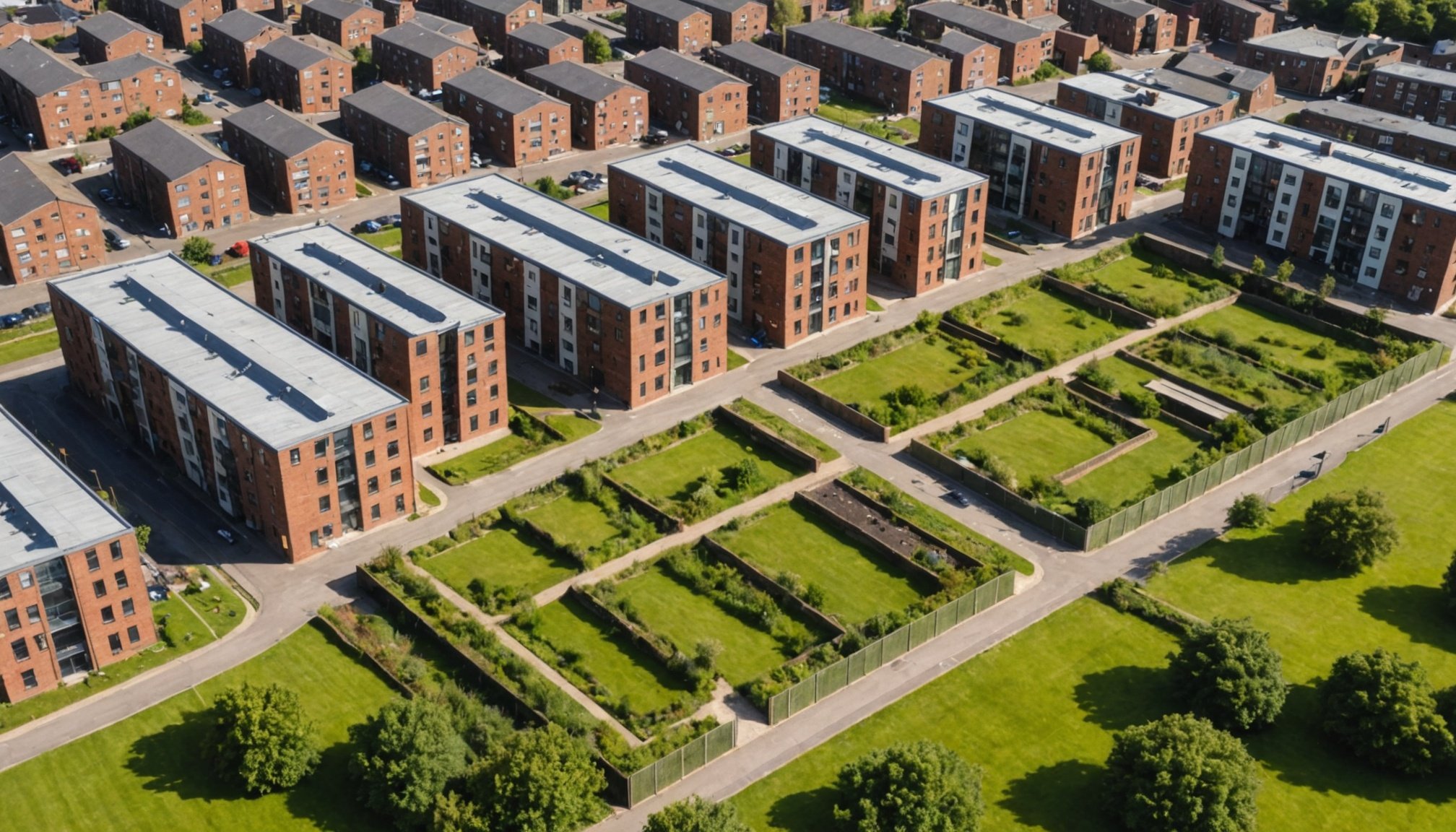Overview of Brownfield Sites
Brownfield redevelopment plays a crucial role in modern urban planning. Brownfield sites are previously developed lands that are not currently in use and may be potentially contaminated. These sites often pose challenges due to their contaminated nature, but they also offer significant opportunities for housing development.
Transforming brownfield sites into housing developments addresses urban planning needs by making efficient use of existing land, reducing urban sprawl, and revitalising neglected areas. This kind of redevelopment can breathe new life into communities, providing affordable housing options and improving the quality of life for residents.
In the same genre : Essential fire safety solutions for aging high-density housing in london: your complete guide
Currently, there is considerable potential for growth in the UK, as many brownfield sites remain underutilised. Statistics indicate that there are over 66,000 hectares of brownfield land suitable for redevelopment, capable of providing more than one million new homes. Urban planners face the exciting challenge of incorporating sustainable practices into these projects, ensuring that developments meet environmental standards while fulfilling housing demands.
Through effective urban planning, brownfield redevelopment holds the promise of transforming disused land into vibrant, sustainable communities. By prioritising housing development on these sites, cities can accommodate growing populations and foster inclusive urban environments.
Topic to read : Mastering market strategies: leveraging geospatial data for informed real estate investment and analysis
Challenges and Barriers
Redeveloping brownfield sites presents numerous challenges and barriers. One primary hurdle is the environmental remediation required before construction can commence. Addressing contamination concerns is both time-consuming and costly, necessitating thorough environmental assessments.
Another significant barrier is securing adequate funding for redevelopment projects. This can be a complicated process, as financiers may view brownfield sites as high-risk investments. Developers often need to seek public-private partnerships or government grants to bridge financial gaps.
Community resistance can also impede progress, particularly if the local population perceives potential development as a threat rather than an improvement. Misinformation or misconceptions about the implications of redevelopment can create opposition. Engaging with stakeholders from the beginning is essential to mitigate such concerns.
Moreover, the intricate nature of regulations governing brownfield redevelopment often adds complexity. Navigating planning approvals can slow projects down, impacting timelines and costs. Understanding and adhering to local policies is crucial to successfully overcoming these hurdles.
Despite these challenges, successful redevelopment can result in significant benefits. Addressing each obstacle with careful planning and strategic partnerships can transform once-derelict lands into thriving urban spaces, meeting housing development demands and enhancing communities.
Innovative Strategies for Transformation
Discovering creative redevelopment strategies can significantly transform brownfield sites into thriving urban spaces. One innovative approach is the adaptive reuse of existing structures. This method involves repurposing old buildings for new functions, preserving cultural heritage while minimising demolition waste. It not only breathes new life into underutilised spaces but also aligns with sustainable building practices.
Integrating green spaces and community amenities is another key strategy. By designing layouts that include parks, recreational areas, and public facilities, developers can enhance the quality of life for residents and foster a strong sense of community. Green infrastructure contributes to urban biodiversity and reduces the heat island effect, proving beneficial for both the environment and public health.
Embracing technological advancements in sustainable construction is crucial for effective urban regeneration. Innovative materials and techniques, such as energy-efficient systems and modular construction, offer cost-effective and environmentally-friendly solutions. These advancements reduce carbon footprints and achieve higher standards of sustainability.
By employing these strategies, cities can turn brownfield sites into vibrant, functional communities. Leveraging technology and creative planning ensures developments meet modern demands while respecting environmental and societal needs. These efforts demonstrate the potential of brownfield redevelopment to contribute to urban rejuvenation and sustainable living.
Regulatory Frameworks
The regulatory frameworks governing brownfield redevelopment in the UK are pivotal to guiding construction and ensuring safety standards. These frameworks ensure that mired land is transformed within the scope of existing legal structures and policies. Understanding and navigating these policies is crucial for developers aiming to integrate successfully into urban planning.
Overview of UK Regulations
The UK hosts a comprehensive suite of regulations that govern brownfield site redevelopment. These regulations address environmental concerns, land use, and public health considerations. Key regulatory bodies, such as the Environment Agency and local councils, play a significant role in assessing and approving redevelopment projects.
Role of Local Councils and Planning Authorities
Local councils are instrumental in reviewing project proposals to ensure alignment with urban planning priorities. They collaborate with planning authorities to shape developments that effectively serve community needs while adhering to sustainability guidelines. Their involvement is crucial in issuing necessary permits and guiding developers through compliance processes.
Key Policies Influencing Redevelopment Projects
Policies like the National Planning Policy Framework establish benchmarks for housing development on brownfield sites. They promote sustainable practices, encouraging efficient land use and prioritising ecological considerations. Such policies empower developers to create innovative housing solutions while respecting environmental and societal imperatives.
Sustainability Considerations
When engaging in brownfield redevelopment, prioritising sustainability is crucial. Environmental assessments play a pivotal role in determining the ecological conditions of a site and ensuring that any development plans mitigate negative impacts. Accurately identifying contamination levels guides remediation efforts and safeguards both public health and the environment.
Implementing sustainable design principles is essential for housing projects on brownfield sites. This includes using eco-friendly materials, maximising energy efficiency, and promoting renewable energy sources. These practices help reduce the overall carbon footprint of developments and ensure long-term environmental benefits.
Minimising the ecological footprint of redevelopment projects involves innovative strategies such as green building certifications and efficient water management systems. By integrating sustainable practices from the planning phase through to completion, developers not only meet regulatory standards but also enhance the community’s quality of life.
Incorporating urban biodiversity through green spaces and integrating natural ecosystems into urban designs promotes sustainability. Such approaches provide habitats for local wildlife and enhance the urban landscape, contributing to both ecological health and public well-being.
These sustainability considerations are vital in transforming brownfield sites into resilient, thriving communities, ensuring that development aligns with modern environmental standards and societal needs.
Successful Case Studies
Exploring real-world case studies reveals valuable insights into effective brownfield redevelopment. These examples illustrate successful projects, highlight lessons learned, and demonstrate transformative impacts on communities.
Case Study 1: King’s Cross Regeneration
This iconic project revitalised the formerly derelict area into a vibrant, mixed-use neighbourhood. Key features included the adaptive reuse of Victorian structures, retaining cultural heritage while introducing modern facilities. The approach balanced preservation with urban innovation.
Community impact was substantial, with increased housing availability and public spaces fostering social cohesion. Addressing contamination required strategic remediation efforts, illustrating the importance of environmentally sound solutions. Challenges such as financial constraints were tackled through public-private partnerships, ensuring the project’s viability.
Case Study 2: Elephant Park
Focused on sustainable housing, Elephant Park exemplifies impactful urban regeneration. The project’s scope encompassed eco-friendly design and cutting-edge renewable technologies. Economic benefits are evident through job creation and local business stimulation, proving transformative for the area’s economy.
Sustainability measures included energy-efficient buildings and extensive green infrastructure. This adherence to eco-friendly practices reduces the project’s overall carbon footprint and enhances ecological value for the community.
Case Study 3: Riverside Sunderland
Success in Riverside Sunderland arose from innovative housing solutions and active stakeholder engagement. The collaboration between developers, local authorities, and communities facilitated effective planning, ensuring long-term support. Notable outcomes are improved accessibility and diverse housing options, cementing its role as a model for future developments.
Future Trends in Urban Development
As urban landscapes evolve, notable future trends in brownfield redevelopment are shaping the UK. A significant shift is towards mixed-use developments, blending residential, commercial, and recreational spaces. These environments foster vibrant communities where housing, workplaces, and amenities coexist, enhancing the urban living experience.
The rise of community-centric designs is also a pivotal trend. This approach prioritises inclusivity and connectivity, encouraging designs that facilitate social interaction. Developments are increasingly integrating public spaces to foster community engagement, promoting an active and unified urban lifestyle.
Flexibility and adaptability in urban planning are crucial to future progress. Innovative solutions like modular construction offer versatility, enabling developments to swiftly respond to changing demands. As cities grow, this adaptability ensures that developments meet evolving needs, accommodating diverse population dynamics.
Digital technology will play a growing role, with smart infrastructure enriching urban environments. This includes efficient transportation planning and energy management, reinforcing sustainability goals.
These trends highlight an optimistic future for brownfield sites. Embracing flexibility and forward-thinking design, they are positioned to play a crucial role in addressing housing shortages and fostering sustainable communities within the UK’s urban landscape.
Community Engagement Strategies
Transforming brownfield sites into vibrant communities necessitates effective community involvement. Engaging local populations from the onset of redevelopment projects can alleviate conflicts and foster support. Best practices include community workshops and public forums that facilitate open dialogue between residents and developers.
Public participation is essential for aligning redevelopment with community needs. Gathering input through surveys and feedback sessions ensures that plans resonate with local aspirations. Residents often bring valuable insights that might otherwise be overlooked, paving the way for more inclusive urban regeneration.
Stakeholder engagement can be pivotal for successful brownfield redevelopment. Engaging a diverse array of community, business, and government stakeholders leads to more robust development strategies. This collaborative approach often incorporates local knowledge and resources, which can enhance project outcomes.
Examples of successful community-driven projects highlight the benefits of inclusive planning. Developments that prioritise stakeholder collaboration often see enhanced social cohesion and public approval. By fostering connections and understanding through active engagement, brownfield projects manage to address concerns effectively, paving the way for innovative housing solutions that bolster urban resilience and sustainability.
Ensuring consistent community engagement throughout the redevelopment process is key. It contributes to better design outcomes and increases the likelihood of creating thriving, sustainable urban environments.
Economic Impacts of Redevelopment
Redevelopment of brownfield sites has notable economic benefits, revitalising local economies through strategic housing projects. Transforming these underutilised areas bolsters regional economic health and contributes to national growth. Key benefits include attracting investment, increasing property values, and stimulating retail and service sectors nearby.
A significant economic benefit is job creation. Construction and subsequent maintenance of housing developments on brownfield sites provide temporary and permanent employment opportunities. Skilled, semi-skilled, and professional roles arise from these projects, contributing to community well-being and reducing unemployment rates.
Moreover, redeveloped housing sites potentially lead to increased local economy activity. New residents boost demand for local services and products, benefitting businesses and encouraging new enterprises. This influx can turn previously neglected areas into bustling, economically vibrant districts.
Long-term advantages encompass enhanced infrastructure and elevated municipal revenues through taxes and fees. As infrastructure improves, cities can attract a diverse pool of residents and businesses, reinforcing urban growth and sustainability. Socio-economic conditions tend to improve as well, fostering a better quality of life.
Addressing economic revitalisation through effective redevelopment strategies can turn brownfield projects into catalysts for broader urban and regional growth. These investments not only improve economic metrics but also reshape community dynamics.

